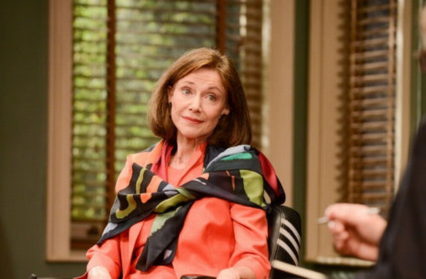Theatre Clwyd’s Duet For One by Tom Kempinski is an intense, painstaking evaluation of how illness or disability can undermine selfhood and autonomy. Through the structure of a series of therapy sessions, we are afforded the somewhat voyeuristic opportunity of being present as Stephanie Abrams slowly pulls down her own walls, revealing the emotional agony that she can’t help but feel.

In many ways, there’s certainly a reliance on cliche built into the heart of this play Duet For One. Our two characters are shameless archetypes: the Strong Woman Facing Disaster and the Overly Insightful European Psychiatrist. Dr Feldmann’s first major breakthrough in her case comes when he suggests that it may have helped her had she had children, while she sits in amazement at the suggestion. It’s hard to overlook the layers of presumption and prejudice that have been embraced in psychiatry over the years, and it feels rather cheapening to watch the assertion that a highly successful woman would be happier as a mother not only put back on the centre stage but applauded while it’s there.
There’s another layer built into the power dynamics that surround and control Stephanie in Duet For One. While we never see or hear him, her husband chose this psychiatrist. Through her later career, she, a musician, has mostly played music composed by him. She continues the sessions against her will but at his request. In the light of her illness, she now hopes to support his career through secretarial work. For a woman who is externally so poised and powerful, it’s striking to see the effective control that her marriage continues to exert.
The sphere of the psychiatrist’s office in Duet For Play quickly forms itself into a place where the power imbalances of the outside world are thrashed out without the restrictions of the convention. Here, it becomes appropriate to mock and derail, to mock accents and to overstep boundaries. Through a rebalancing of power in this far smaller arena, the real world is perhaps somehow momentarily balanced in the same way. The set, a delightfully detailed and timeless psychiatrist’s office seemingly suspended in and surrounded by blackness, add to this: for all its connection to reality, this space is a world alone, with space for rage and grief on an unimaginable scale, but with little consequence to come from these things.
It’s notable that in the final section of act one of Duet For Play, Stephanie appears in clothes that incidentally match the office’s colour scheme. In her final lines of the act, we learn that her practice room, her most intimate and private space, is blue. Like the suit, Dr Feldmann wears at that moment. There’s something lovely in this – a sense of human unity that the act has built gently towards, coming to an impossibly neat conclusion as each manages to draw close to the other for the first time. The parts, after an hour of twisting and turning, have finally slotted together.
It’s a shame that the same can not be said for the end of Act Two of Duet For One. We’re left-right on a turning point, with numerous unsolved problems and unanswered questions. The end feels more like a cutoff, more the playwright simply walking off than finishing the piece. While this is frustrating, there’s also a sense of being invited to share Stephanie’s pain with her. If her artistic career was so brutally shortened, why should we expect the story of that loss to reach a neat and narratively satisfying conclusion?
The team behind Duet For One, Theatre Clwyd offers a variety of theatre performances.
Grace Patrick is an avid contributor to Wales Arts Review.











